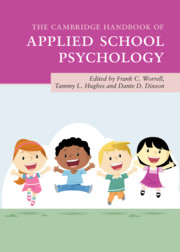Book contents
- The Cambridge Handbook of Applied School Psychology
- The Cambridge Handbook of Applied School Psychology
- Copyright page
- Contents
- Contributors
- Contributor Biographies
- Acknowledgments
- 1 Broadening the Focus of School Psychology Practice
- Part I Individual-Level Academic Interventions
- Part II Teacher- and System-Level Interventions
- Part III Interventions from Educational and Social/Personality Psychology
- Part IV Behavioral and Social-Emotional Interventions
- Part V Health and Pediatric Interventions
- Part VI Family Connections and Life Transitions
- Part VII Special Populations
- 33 School Psychologists in Early Childhood Settings
- 34 Identifying and Serving Gifted and Talented Students
- 35 How Best to Serve Court-Involved Youth in Schools
- 36 School-Based Interventions for Refugee Children and Adolescents
- Part VIII Conclusion
- Index
- References
34 - Identifying and Serving Gifted and Talented Students
from Part VII - Special Populations
Published online by Cambridge University Press: 18 September 2020
- The Cambridge Handbook of Applied School Psychology
- The Cambridge Handbook of Applied School Psychology
- Copyright page
- Contents
- Contributors
- Contributor Biographies
- Acknowledgments
- 1 Broadening the Focus of School Psychology Practice
- Part I Individual-Level Academic Interventions
- Part II Teacher- and System-Level Interventions
- Part III Interventions from Educational and Social/Personality Psychology
- Part IV Behavioral and Social-Emotional Interventions
- Part V Health and Pediatric Interventions
- Part VI Family Connections and Life Transitions
- Part VII Special Populations
- 33 School Psychologists in Early Childhood Settings
- 34 Identifying and Serving Gifted and Talented Students
- 35 How Best to Serve Court-Involved Youth in Schools
- 36 School-Based Interventions for Refugee Children and Adolescents
- Part VIII Conclusion
- Index
- References
Summary
In this chapter, we address identifying and serving students with academic potential and promise. We briefly review the literature on racial and socioeconomic gaps at the highest levels of achievement (i.e. excellence gaps) and how schooling does little to close them. We then present a framework for talent development that moves gifted education from a singular focus on the identification of children already displaying high levels of accomplishment to a greater focus on providing services that develop potential talent in the form of increased opportunities to learn. We review promising identification practices and program models that serve a broader range of gifted learners.
- Type
- Chapter
- Information
- The Cambridge Handbook of Applied School Psychology , pp. 598 - 612Publisher: Cambridge University PressPrint publication year: 2020



